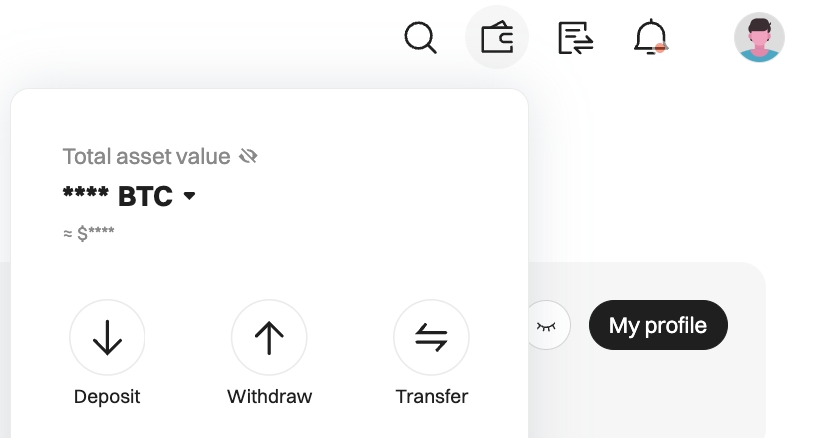
How to buy Bitcoin (BTC) in Peru
Simple 3-step guide to buying BTC today in Peru
Step 1: Create a free account on the Bitget website or the app
Step 2: Place an order for Bitcoin using a payment method of your choice:
Buy Bitcoin with a debit/credit card
For Visa or Mastercard, select Credit/Debit card, then click Add New Card under the "Buy" tab Credit/Debit in the Buy Crypto tab of the Bitget app
Credit/Debit in the Buy Crypto tab of the Bitget app Credit/Debit in the Buy Crypto tab of the Bitget websiteSelect your preferred fiat currency, enter the amount you wish to spend, link your credit card, and then complete your payment with zero fees.
Credit/Debit in the Buy Crypto tab of the Bitget websiteSelect your preferred fiat currency, enter the amount you wish to spend, link your credit card, and then complete your payment with zero fees. Add a new card to complete your payment on the Bitget app
Add a new card to complete your payment on the Bitget app Enter your bank card details to complete your payment on the Bitget websiteFor Diners Club/Discover card, click Buy Crypto > [Third Party] in the top navigation bar to place your Bitcoin order.
Enter your bank card details to complete your payment on the Bitget websiteFor Diners Club/Discover card, click Buy Crypto > [Third Party] in the top navigation bar to place your Bitcoin order. How to buy crypto with credit/debit card
How to buy crypto with credit/debit cardBuy Bitcoin with Google Pay or Apple Pay
Converting your Google Pay and Apple Pay balance into Bitcoin is easy and secure on Bitget. Simply click Buy Crypto > [Third Party] in the top navigation bar to place your Bitcoin order. How to buy crypto via third-party gateway
How to buy crypto via third-party gatewayBuy with bank transfer
We accept various payment methods, including iDeal and SEPA for EUR, PIX for BRL, PayID for AUD, UPI for INR, QRIS, DANA, and OVO for IDR, SPEI for MXN, and GCash for PHP. These services are facilitated by Alchemy Pay, Banxa, Mercuryo, and Simplex payment gateways. Simply select Buy Crypto > [Third Party] in the top navigation bar and select a fiat currency to place your Bitcoin order.Buy Bitcoin with the fiat balance in your Bitget account
You can Deposit fiat funds using Advcash, SEPA, Faster Payments, or PIX payment gateways to top up your Bitget fiat balance. Then, click Buy Crypto > [Cash conversion] in the top navigation bar to place your Bitcoin order.P2P trading
With Bitget P2P, you can buy crypto using over 100 payment methods, including bank transfers, cash, and e-wallets like Payeer, Zelle, Perfect Money, Advcash, and Wise. Simply place an order, pay the seller, and receive your crypto. Enjoy secure transactions with escrow protection. How to buy crypto on Bitget P2P
How to buy crypto on Bitget P2P
Step 3: Monitor Bitcoin in your Bitget spot wallet

Latest Bitcoin news
View moreBuy Bitcoin
Bitget—where the world trades Bitcoin






FAQ
How can I buy Bitcoin on Bitget?
Can I buy just $1 worth of Bitcoin?
What payment options does Bitget support for Bitcoin purchases?
Where can I find the best platform to buy Bitcoin?
Is now a good time to invest in Bitcoin?
What fees should I expect when purchasing Bitcoin?
What is the minimum BTC required to start investing in Bitget?
How many Bitcoins are still available to mine?
What is Bitcoin's share of the global money supply?
What should I do if I encounter issues while buying Bitcoin?
Buy Bitcoin in a different country
Located on the Pacific coast of South America, Peru is the third largest country in the continent, boasting a population of 32 million. Lima stands as both its capital and biggest city and is home to almost a third of the country’s entire population, overlooking Peru’s scenic western coast while serving as the nation’s political, financial, commercial, and cultural hub.
If you’re a fan of the great outdoors, Peru is perfect for those looking to experience a diverse range of biomes, spanning from the Pacific Ocean by the west to the famed Andes mountains running from north to south and finally to the Amazon Rainforest and River located in the east.
Economically, Peru is also one of the region’s most prosperous countries, reporting an average growth rate of 5.9% in 2017 and an industrial growth rate of 9.6% as of 2018. It forms part of an economic group in Latin America known as The Pacific Pumas and also actively partakes in the Asia-Pacific Economic Cooperation forum, the Pacific Alliance trade bloc, the Comprehensive and Progressive Agreement for Trans-Pacific Partnership, and the World Trade Organization.
Peru’s national currency is the Sol (PEN), and with direct support from Bitget, you can purchase Bitcoin(BTC) in a matter of minutes, whether you’re in Lima, Arequipa, Trujillo, Chiclayo, or elsewhere in the country. Our exchange uses a variety of secure methods including P2P trading, crypto deposits, and other third-party merchants such as Apple Pay, Google Pay, and numerous credit cards to offer you plenty of payment options with proven security.